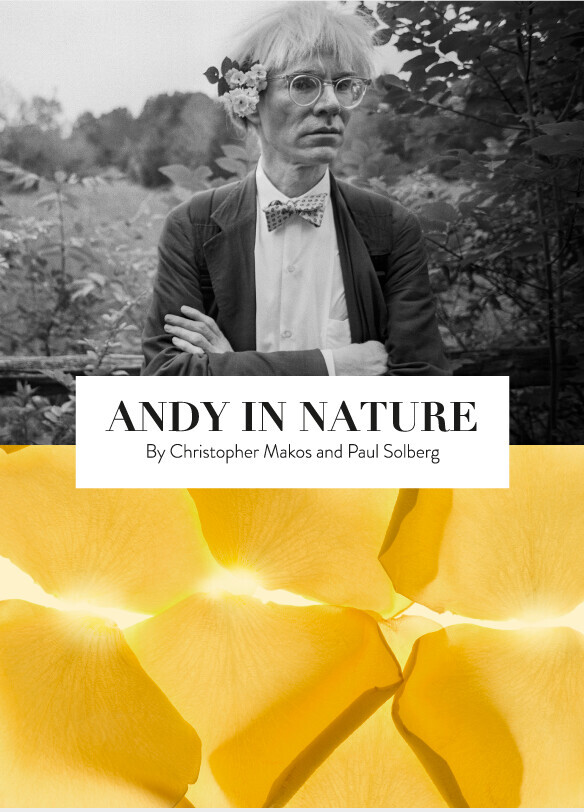
5 October 2025
ANDY IN NATURE
Time
see BELOW for hours
Venue
FOREST HALL
Program
EXHIBITION HOURS: Thursdays + Sundays from 12-5 p.m., and Fridays + Saturdays 1-9 p.m.
ANDY IN NATURE
Andy Warhol (1928-1987) has typically been perceived as a personification of the consumer society that marked the second half of the 20th century. Famous for his focus on celebrity and industry, he became synonymous with all that is manufactured by man and machine. The hive of his artistic output was known as 'The Factory’, perhaps a nod to the industrial and mass produced.
Andy in Nature explores Warhol through a very different lens, that of photographers Christopher Makos and Paul Solberg, showing the disparate influence Warhol had on these two artists.
Makos was by Warhol’s side for much of the 1970’s and 80’s. He presents a new and under-appreciated dimension of Warhol: his relationship with nature. The charge in Makos photographs, many of which are exhibited here for the first time, comes from their challenge to the media caricature of Andy Warhol as a plasticine-like figure — the famous face of Campbell’s Soup, Brillo, Pepsi Cola and Burger King. Instead, he is seen in these images, in a field, by the beach in Montauk, on a mountain in Colorado, or in a rowboat in Paris. To see Andy Warhol in these unexpected and seemingly out of context settings is surprising to the eye. The images ask us to do a double take and reconsider our perceptions of Warhol the man, by adding yet another layer to his complex and enigmatic figure.
The exhibit is a departure for Makos. A famous urbanite himself, acclaimed for his documentation of the urban world around him: the artistic and literary life of Downtown Manhattan, colliding with the glitterati scene Uptown, and the coexistence of the two worlds, unique to 70’s and early 80’s Manhattan. In this exhibit, Makos strays completely from the city themes. Absent are the shots of Studio 54, the Mudd Club, and the bacchanalian excesses of the era. Instead, in Andy in Nature, we gain access to another dimension of Makos’s body of photographic work, as well as a more contemplative look at Andy Warhol: it is two friends on holiday- usually a work holiday for Andy- removed from the urban environments for which they are best known to inhabit.
Warhol’s influence is omnipresent with artists that came after him. Solberg is not immune from his hand, both for the Warholian business acumen passed down from Makos, and artistically, the merits of restraint and impact of scale.
Paul Solberg, whether it’s his ethereal portraits of human beings or flowers, his approach is the audacity of simplicity. Solberg leaves the subject nowhere to hide, distilling the singular essence of his subject with the brush of light. His process is as much the photographing of light as it is the protagonist in his frame. He luxuriates on his subjects; the skin of the flower given the same adulation as his human subjects. There is a scrutiny to his method, elevating the smallest flower into a landscape. There are three examples in this exhibition, from Solberg’s “Eight Series” (2008), where he has taken apart the original architecture of the flower, creating rolling landscapes of pedals, with light as the compass through the rolling hills of his ephemeral sculpture. You see a similar artist’s adoration for their subject in Georgia O’Keefe’s animal skeletons paintings against blue sky, or Warhol’s “Liz” or “Flowers” silkscreens, where the artist is taken somewhere irrational, elevating a subject as Idol. For Solberg, the message is clear: “to save ourselves, nature must once again be worthy of our worship.”
ANDY DANDY: MAKOS + SOLBERG
The third part of the exhibition weaves the three generations of artists with the 18-year collaboration of “the Hilton Brothers’, the moniker and second identity Makos and Solberg have shared since 2004. It’s the melding of contrasting perspectives to create another side to a story: as they did with Hippofolium (2005), We the People (2014), and in this exhibition, Andy Dandy (2007).
The Rosetta stone of Andy Dandy was the result of Makos and Warhol’s collaboration "Altered Image" (c.1981). Warhol’s appearance is with make-up and a wig, otherwise remaining in street clothes. It wasn’t drag, and it wasn’t changing gender, but rather, showing the potency of these symbols and how they shift perception. Makos and Warhol’s inspiration came from Rose Sélavy (1920), the collaboration of Man Ray and Duchamp decades earlier.
“Andy Dandy” (2007) is a series of twenty diptychs, which considers the rich association between Andy Warhol and flowers, creating a kinetic dialogue between Makos' and Solberg's work. Much like the "Altered Image" portraits, Solberg’s used an opaque white environment in his early flower work, providing a weightless transition between Andy and the flower, and the two bodies of work naturally found themselves connected on Makos and Solberg’s studio floor.
More Information
Above all, this exhibition pays homage to the birthplace of the American Conservation Movement, Forest Hall, and the historic town of Milford. Forest Hall has a rich history of examining and celebrating the intimate relationship between art and nature. The original portion of the building, designed by Calvert Vaux, included a studio space for some of the most prominent Hudson River School painters, including Worthington Whittredge, John Weir, Jervis McEntee and Sanford Gifford. The extended section where Andy in Nature is on view, was built in 1904 to house Yale University Forestry’s School summer program, bringing the first generation of American Foresters to Milford.